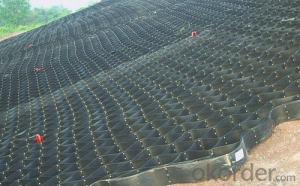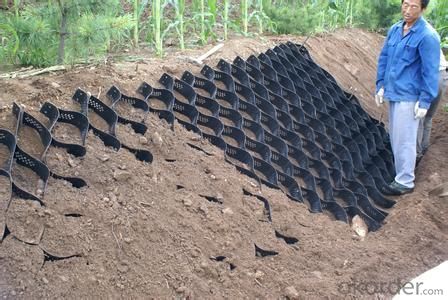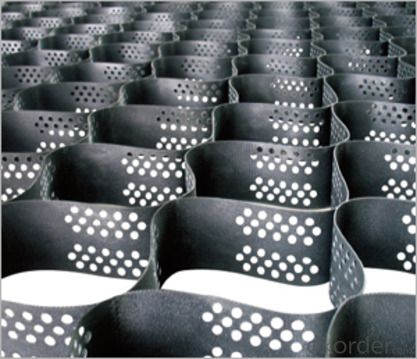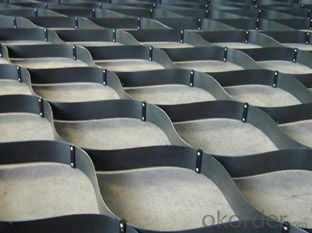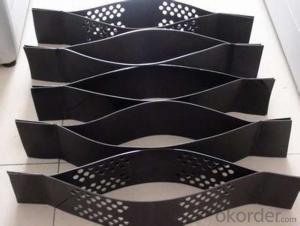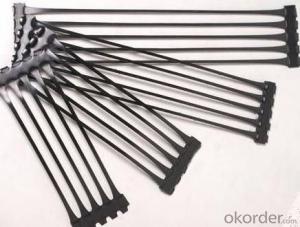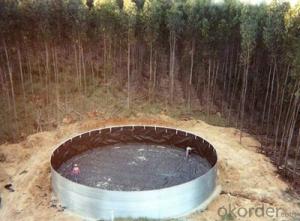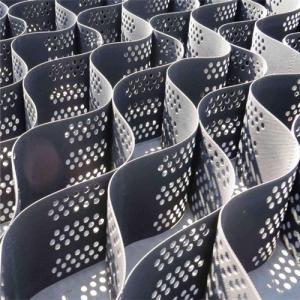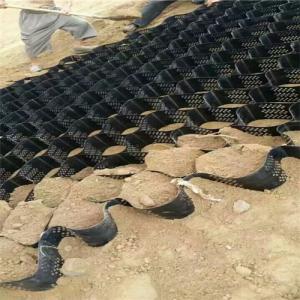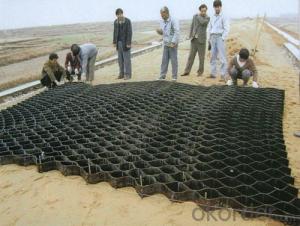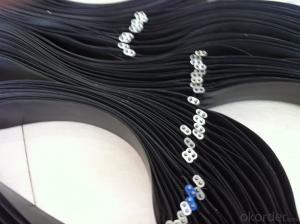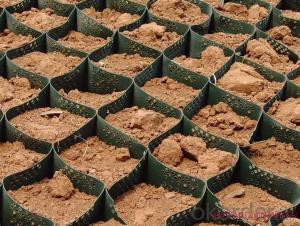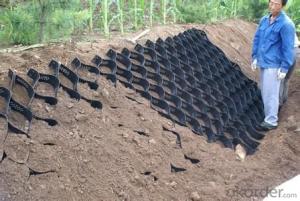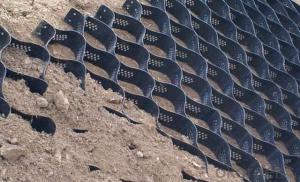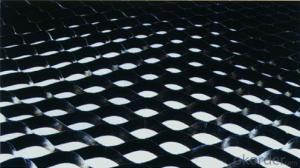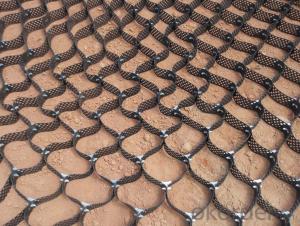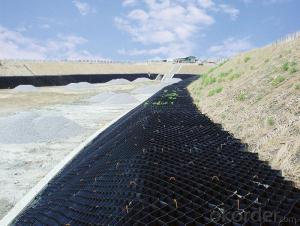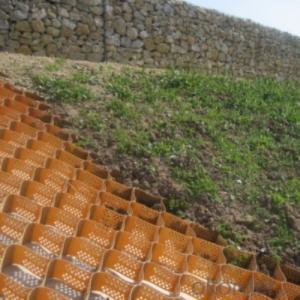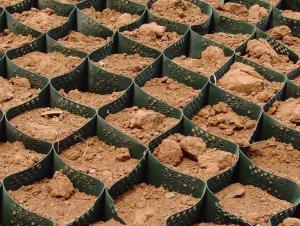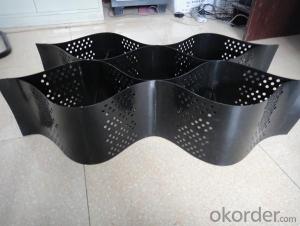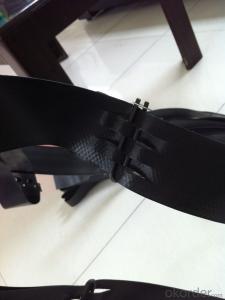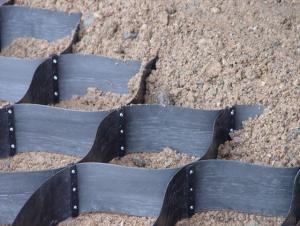CE Certified HDPE Geocells for Erosion Control in Road Construction
- Loading Port:
- Qingdao
- Payment Terms:
- TT OR LC
- Min Order Qty:
- 10000 m²
- Supply Capability:
- 300000 m²/month
OKorder Service Pledge
OKorder Financial Service
You Might Also Like
Description Of HDPE Geocell used in Road Construction
Geocell is made of high-strength HDPE or PP broadband, which are welded into a piece of netty cell structure, it can be stretched out and folded easily. It can be folded in course of conveyance while being stretched out; soil, stone or concrete can be filled into it, which will become a structure body with big side restriction and high strength. It can be used as a cushion to deal with weak foundation increasing the load capacity, and can also be laid on the slope to be made up the protecting structure.
Main Features of HDPE Geocell used in Road Construction
1. Retractile,foldable when transportation,pulled to network when construction,fill in the soil,gravel,concrete etc. loose materials,form one structure with strong lateral limitations and high stiffness;
2. Material is light,abrasion resistance,chemical properties stable,resist photooxidation aging,acid and alkali resistant,suiltable for different soil and soil conditions,such as desert;
3. Good lateral restrict and preven slippery,prevent deformation,effectively enhance the bearing capacity of subgrade and dispersed loads function;
4. The geocell height and welding distance etc. geometric dimensions are all changeable in order to meet the requirements of different projects;
Specifications of HDPE Geocell used in Road Construction
| Item | Geogrid Chamber | High Strength Geogrid |
| Tensile Strength of Sheet Materials Mpa | ≥23 | ≥200 |
| Tensile Strength of Weided Seam N/cm | ≥100 | ≥150 |
| Distance of Welding (mm) | 330-550 | |
| Stretched Size (m×m) | 4×5~6×7 | |
Applications of HDPE Geocell used in Road Construction
1. It has retractable, contractible fold when transportation, it can be tensioned reticulated when construction , fill dirt, gravel, concrete and other loose material , constitute a powerful lateral limits and great structure stiffness .
2. Light weight, wear resistance, chemical stability, light oxygen aging, acid, suitable for different soil and desert soil conditions.
3. Higher lateral restrictions and non-slip, anti-deformation, effectively enhance the load bearing capacity and decentralized subgrade.
4. Geocell change the height, distance and other weld geometries to meet different project needs.
5. Connection is convenient, fast construction speed
IMages of HDPE Geocell used in Road Construction
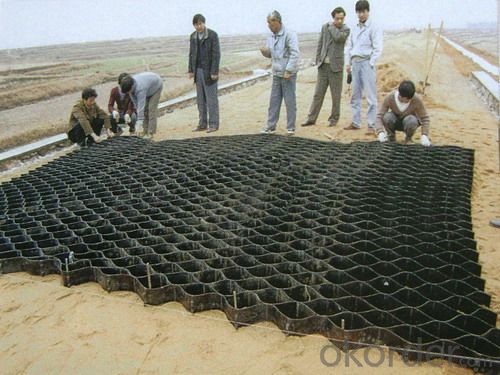

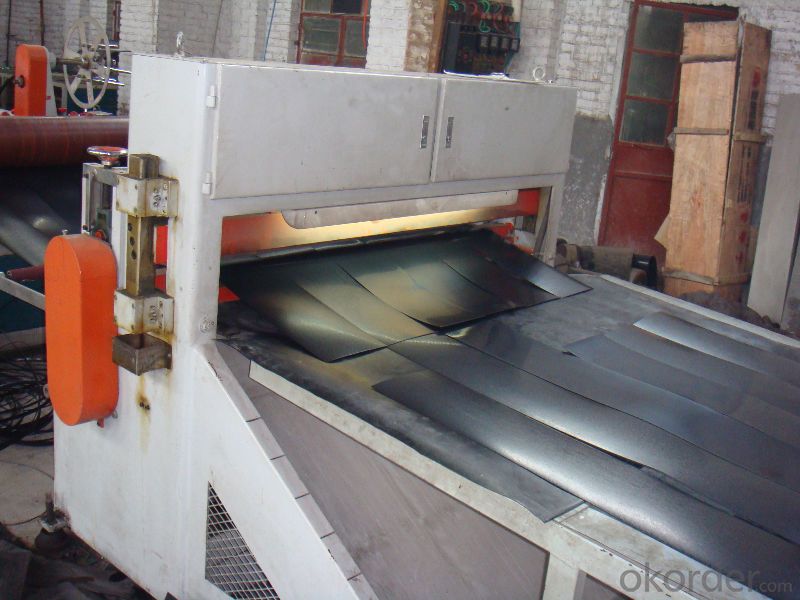
RFQ:
Q1:Can you provide a sample for us?
A:yes,we can provide for your free samples based on freight collect.
Q2:What is your MOQ?
A:MOQ is 10000sqm.
Q3:What is payment terms?
A:T/T,L/C
Q4:What is your lead time?
A:According to your order quantity,usually 7days for 1*40HC
Q5:Do the customized design accepted?
A:We welcome customized design.
- Q: How do geocells improve the performance of reinforced slopes in seismic zones?
- Geocells improve the performance of reinforced slopes in seismic zones by providing increased stability and resistance against soil liquefaction during earthquakes. The cellular confinement system created by geocells helps to distribute and confine the soil particles, preventing excessive lateral movement. This confinement also enhances the load-bearing capacity of the reinforced slope, reducing the risk of slope failure and improving overall performance in seismic events.
- Q: How do geocells help with load-bearing capacity?
- Geocells help improve load-bearing capacity by confining and stabilizing the infill material, such as aggregate or soil, within their cellular structure. This confinement prevents lateral spreading of the infill material under load, resulting in increased lateral restraint and overall stability. Additionally, the interconnected cells of geocells distribute the applied load over a wider area, allowing for a more efficient load transfer and reducing the stress on the underlying soil or subgrade.
- Q: Can geocells be used in slope reinforcement for railways?
- Yes, geocells can be used in slope reinforcement for railways. Geocells are a proven solution for soil stabilization and erosion control, providing structural support to slopes. They can effectively prevent soil erosion, improve slope stability, and enhance the overall performance of railway slopes.
- Q: Are geocells suitable for road construction?
- Yes, geocells are suitable for road construction. Geocells are three-dimensional, honeycomb-like structures made from high-density polyethylene, which can be filled with soil, aggregate, or other materials. They provide stability and reinforcement to the roadbed, improving load-bearing capacity, reducing lateral movement, and preventing erosion. Geocells also enhance the performance and longevity of roads, making them a suitable option for road construction projects.
- Q: Can geocells be used for flood protection?
- Yes, geocells can be used for flood protection. Geocells are three-dimensional cellular confinement systems made from high-density polyethylene (HDPE) or other materials. They can be filled with soil or other granular materials to create a stable structure that can be used for erosion control, slope stabilization, and flood protection. Geocells help to prevent soil erosion and offer a strong barrier against floodwaters, helping to protect properties and infrastructure from the damaging effects of flooding.
- Q: Can geocells be used in load-bearing platforms for helipads?
- Yes, geocells can be used in load-bearing platforms for helipads. Geocells are engineered cellular confinement systems that provide stability and reinforcement to the ground. They can effectively distribute the load of a helipad, preventing soil erosion and ensuring a stable platform for helicopters to land and take off.
- Q: Can geocells be used in landfills?
- Yes, geocells can be used in landfills. Geocells are a type of cellular confinement system made of interconnected cells that can be filled with various materials like soil or aggregate. They are commonly used in landfill engineering to reinforce steep slopes, provide erosion control, and enhance stability. Geocells also help to distribute loads and increase the load-bearing capacity of landfill liners, making them a suitable solution for improving the overall performance and longevity of landfills.
- Q: What is the thermal stability of geocells?
- The thermal stability of geocells is generally high, as they are designed to withstand temperature fluctuations and maintain their structural integrity. They are typically made from materials that have good resistance to heat, such as high-density polyethylene (HDPE), which can withstand temperatures ranging from -50°C to 85°C without significant deformation or degradation. This thermal stability ensures that geocells can effectively perform their intended functions even in environments with extreme temperature variations.
- Q: Can geocells be used in slope greening projects?
- Yes, geocells can be used in slope greening projects. Geocells are three-dimensional honeycomb-like structures made from various materials, such as plastic or geotextiles, which are filled with soil or vegetation. They provide stabilization, erosion control, and support to slopes while promoting vegetation growth. Geocells can retain soil and water, prevent erosion, and create a stable base for plants to grow, making them suitable for slope greening projects.
- Q: Are geocells suitable for use in landfill applications?
- Yes, geocells are suitable for use in landfill applications. They provide effective erosion control, stability, and reinforcement to the landfill slopes. Additionally, geocells help manage stormwater runoff, prevent soil loss, and enhance the overall structural integrity of the landfill.
Send your message to us
CE Certified HDPE Geocells for Erosion Control in Road Construction
- Loading Port:
- Qingdao
- Payment Terms:
- TT OR LC
- Min Order Qty:
- 10000 m²
- Supply Capability:
- 300000 m²/month
OKorder Service Pledge
OKorder Financial Service
Similar products
Hot products
Hot Searches
Related keywords
